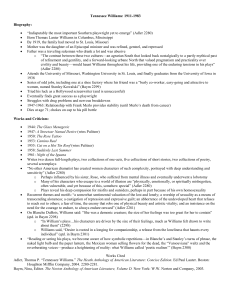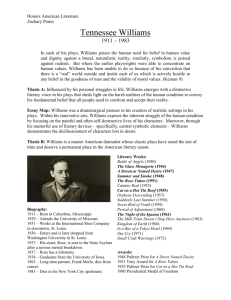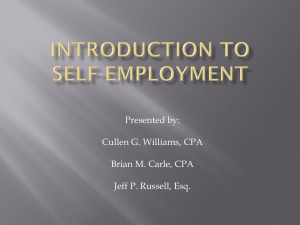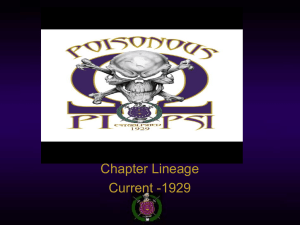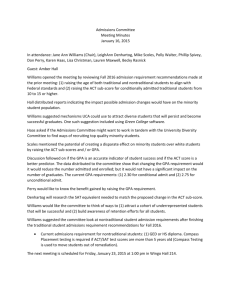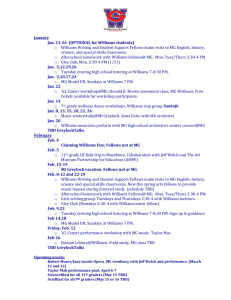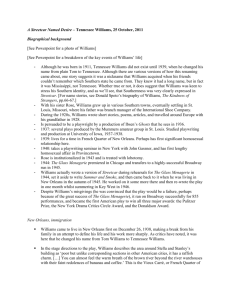More on Historical Context
advertisement
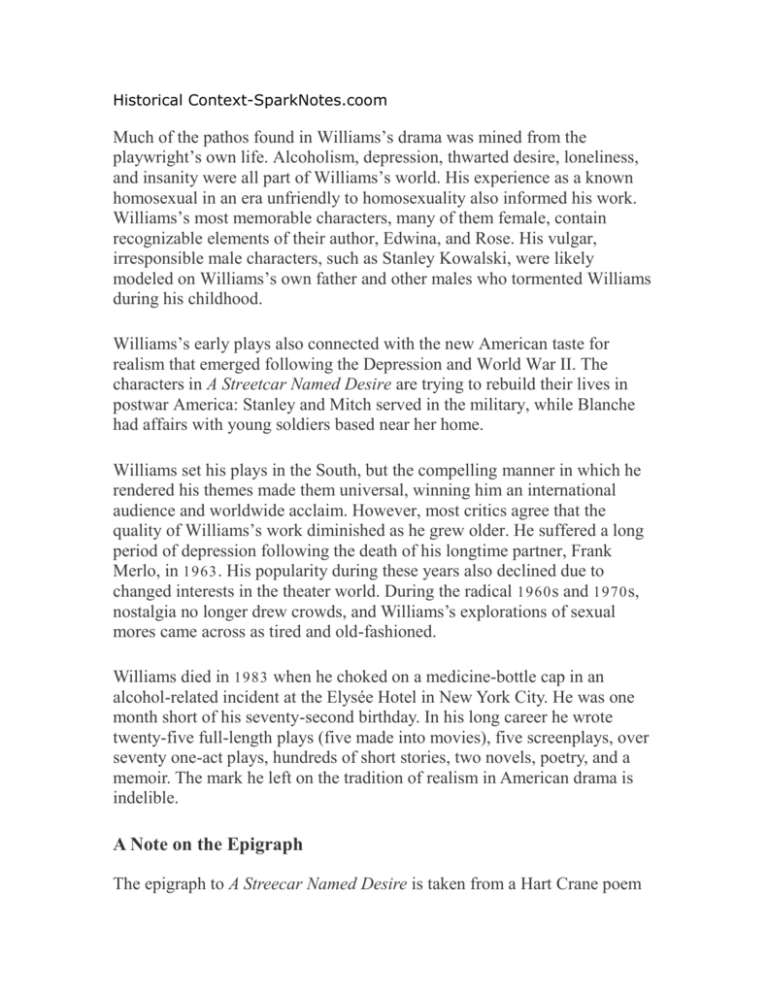
Historical Context-SparkNotes.coom Much of the pathos found in Williams’s drama was mined from the playwright’s own life. Alcoholism, depression, thwarted desire, loneliness, and insanity were all part of Williams’s world. His experience as a known homosexual in an era unfriendly to homosexuality also informed his work. Williams’s most memorable characters, many of them female, contain recognizable elements of their author, Edwina, and Rose. His vulgar, irresponsible male characters, such as Stanley Kowalski, were likely modeled on Williams’s own father and other males who tormented Williams during his childhood. Williams’s early plays also connected with the new American taste for realism that emerged following the Depression and World War II. The characters in A Streetcar Named Desire are trying to rebuild their lives in postwar America: Stanley and Mitch served in the military, while Blanche had affairs with young soldiers based near her home. Williams set his plays in the South, but the compelling manner in which he rendered his themes made them universal, winning him an international audience and worldwide acclaim. However, most critics agree that the quality of Williams’s work diminished as he grew older. He suffered a long period of depression following the death of his longtime partner, Frank Merlo, in 1963 . His popularity during these years also declined due to changed interests in the theater world. During the radical 1960 s and 1970 s, nostalgia no longer drew crowds, and Williams’s explorations of sexual mores came across as tired and old-fashioned. Williams died in 1983 when he choked on a medicine-bottle cap in an alcohol-related incident at the Elysée Hotel in New York City. He was one month short of his seventy-second birthday. In his long career he wrote twenty-five full-length plays (five made into movies), five screenplays, over seventy one-act plays, hundreds of short stories, two novels, poetry, and a memoir. The mark he left on the tradition of realism in American drama is indelible. A Note on the Epigraph The epigraph to A Streecar Named Desire is taken from a Hart Crane poem titled “The Broken Tower.” Crane was one of Williams’s icons. Williams’s use of this quotation is apt, as Crane himself often employed epigraphs from his own icons, including Melville, Whitman, Dickinson, and Blake. Williams felt a personal affinity with Crane, who, like himself, had a bitter relationship with his parents and suffered from bouts of violent alcoholism. Most important, Williams identified with Crane as a homosexual writer trying to find a means of self-expression in a heterosexual world. Unlike Williams, Crane succumbed to his demons, drowning himself in 1932 at the age of thirty-three. Williams was influenced by Crane’s imagery and by his unusual attention to metaphor. The epigraph’s description of love as only an “instant” and as a force that precipitates “each desperate choice” brings to mind Williams’s character Blanche DuBois. Crane’s speaker’s line, “I know not whither [love’s voice is] hurled,” also suggests Blanche. With increasing desperation, Blanche “hurls” her continually, denied love out into the world, only to have that love revisit her in the form of suffering. Article by http://gtownson1.hubpages.com Tennessee wrote numerous plays during his life; and of those the most well known and recognized is his play entitled, A Streetcar Named Desire. This playwas first performed in 1947 (Baym, 2185). The late 1940’s were characterized by fear of government and of nuclear attacks. People felt alienated, they could no longer trust tradition, so they looked for new stability (Baym, 2084). For these reasons, the themes within A Streetcar Named Desire struck a chord with society. A Streetcar Named Desire is more than entertainment. It includes numerous social conflict undertones, which give it relevance, depth, and meaning. Williams wrote in a way so as to pull at the hearts of those in the audience. Through the play, Tennessee Williams: • Considers the effects of the conflict that occurs when society's perception of a person and the person's personal reality do not coincide. • Considers the effects of the personal struggle that occurs when a person's reality does not coincide with their inner-fantasies. • Sheds light on society’s victimization of females and considers the idea of female self-expression (which was still a new idea in William's time). Questions woman’s apparent lack of authority in a society dominated by men. Conclusion “Possible reasons” Williams’ wrote A Streetcar Named Desire: • To highlight the oppressiveness of society. • To promote tolerance and open-mindedness. • To challenge society’s perception of the individual. • To challenge the institution of absolute male authority in Southern society. • To listen and speak for those alienated, victimized, and forgotten by society. • To show how societies view of the individual, tradition, and the victim is flawed. To target the tension that comes when a person’s facade is lifted for the world to see.


